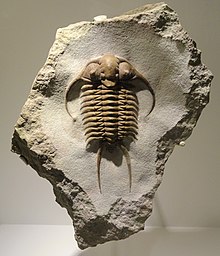
The Ordovician is a geologic period and system, the second of six periods of the Paleozoic Era. The Ordovician spans 41.6 million years from the end of the Cambrian Period 485.4 million years ago (Ma) to the start of the Silurian Period 443.8 Mya.

The Heteroptera are a group of about 40,000 species of insects in the order Hemiptera. They are sometimes called "true bugs", though that name more commonly refers to the Hemiptera as a whole. "Typical bugs" might be used as a more unequivocal alternative, since the heteropterans are most consistently and universally termed "bugs" among the Hemiptera. "Heteroptera" is Greek for "different wings": most species have forewings with both membranous and hardened portions ; members of the primitive sub-group Enicocephalomorpha have completely membranous wings.

The Anatinae are a subfamily of the family Anatidae. Its surviving members are the dabbling ducks, which feed mainly at the surface rather than by diving. The other members of the Anatinae are the extinct moa-nalo, a young but highly apomorphic lineage derived from the dabbling ducks.
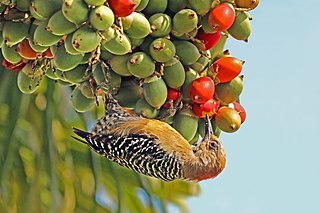
Nine families of largely arboreal birds make up the order Piciformes, the best-known of them being the Picidae, which includes the woodpeckers and close relatives. The Piciformes contain about 71 living genera with a little over 450 species, of which the Picidae make up about half.

Phacopida ("lens-face") is an order of trilobites that lived from the Late Cambrian to the Late Devonian. It is made up of a morphologically diverse assemblage of taxa in three related suborders.

Phacopidae is a family of phacopid trilobites that ranges from the Lower Ordovician to the Upper Devonian, with representatives in all paleocontinents.

Olenellus is an extinct genus of redlichiid trilobites, with species of average size. It lived during the Botomian and Toyonian stages (Olenellus-zone), 522 to 510 million years ago, in what is currently North-America, part of the palaeocontinent Laurentia.
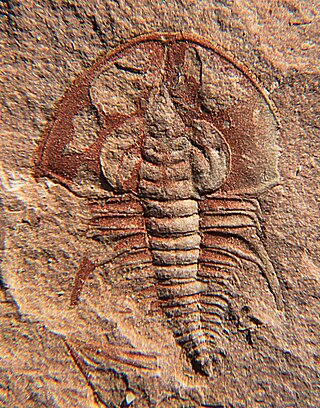
Olenellina is a suborder of the order Redlichiida of trilobites that occurs about halfway during the Lower Cambrian, at the start of the stage called the Atdabanian. The earliest trilobites in the fossil record are arguably Olenellina, although the earliest Redlichiina,Ptychopariida, and Eodiscina follow quickly. The suborder died out when the Lower Cambrian passed into the Middle Cambrian, at the end of the stage called Toyonian. A feature uniting the Olenellina is the lack of rupture lines in the headshield, which in other trilobites assist the periodic moulting, associated with arthropod growth. Some derived trilobites have lost facial sutures again, but all of these are blind, while all Olenellina have eyes.

Chotecops is a genus of trilobites from the order Phacopida, suborder Phacopina, family Phacopidae. It was initially erected as a subgenus of Phacops but some later authors thought it distinctive enough to raise its status. Species assigned to this genus occur between the Emsian and the Famennian. Chotecops is the most abundant trilobite in the Hunsrück Slate and due to the excellent preservation, often soft tissue such as antennae and legs have been preserved as a thin sheet of pyrite.

Paraneoptera or Acercaria is a superorder of insects which includes lice, thrips, and hemipterans, the true bugs. It also includes the extinct order Permopsocida, known from fossils dating from the Early Permian to the mid-Cretaceous.
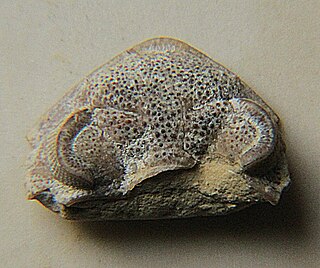
The Pterygometopidae are a family of trilobites, that is known from the Floian to the Katian (Ordovician), and reappears from the Telychian to the Sheinwoodian (Silurian). As part of the Phacopina suborder, its members have schizochroal eyes.

Asaphidae is a family of asaphid trilobites. Although the first genera originate in Upper Cambrian marine strata, the family becomes the most widely distributed and most species-rich trilobite family during the Ordovician. 754 species assigned to 146 genera are included in Asaphidae.
Lotagnostus is a genus of very small trilobites in the order Agnostida, which lived on the outer continental shelves worldwide, during the late Upper Cambrian. It was described by Whitehouse in 1936, and the type species is Lotagnostus trisectus, which was originally described as a species of Agnostus by Salter in 1864.

Diaphanometopidae is a family of trilobites. Its representatives lived during the Arenig and Llanvirn stages of the Ordovician Period, approximately 479 to 463 million years ago. The Diaphanometopidae are thought to have been an early transitional group between the Ptychopariida ancestors and all other Phacopina. Diaphanometopidae, are found in the Lower and Middle Ordovician of Sweden and Russia. Three species are assigned to this family: Diaphanometopus volborthi that has been found in the Dapingian of Baltica, Gyrometopus lineatus occurring in the Floian of Baltica and Prodalmanitina nikolaevi that is known from the Floian of Kolyma. These species have many ancestral characters compared to other Phacopina, but they do not seem to be each other's nearest relatives, which makes it unlikely this family will be maintained when the phylogeny has been studied in more detail.

Trinodus is a very small to small blind trilobite, a well known group of extinct marine arthropods, which lived during the Ordovician, in what are now the Yukon Territories, Virginia, Italy, Czech Republic, Poland, Denmark, Sweden, Svalbard, Ireland, Scotland, Wales, Iran, Kazakhstan and China. It is one of the last of the Agnostida order to survive.
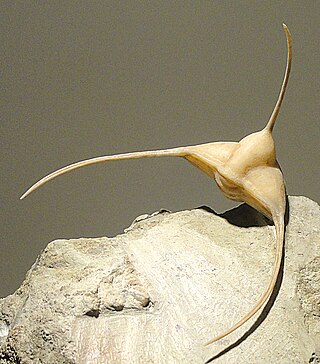
Raphiophoridae is a family of small to average-sized trilobites that first occurred at the start of the Ordovician and became extinct at the end of the Middle Silurian.

The Illaenidae are a family of trilobites in the order Corynexochida. 223 currently accepted species in 24 genera are known from the Ordovician. Some scholars include the Panderiidae in the Illaenidae, but this is not generally supported.

Telephinidae is a family of pelagic trilobites with large wide-angle eyes, occupying most of the free cheeks, downward directed facial spines and 9-10 thorax segments. The family is known during the entire Ordovician and occurred in deep water around the globe.

Trinucleidae is a family of small to average size asaphid trilobites that first occurred at the start of the Ordovician and became extinct at the end of that period. It contains approximately 227 species divided over 51 genera in 5 subfamilies. The most conspicuous character is the wide perforated fringe of the head.

Cheirurina is a suborder of the trilobite order Phacopida. Known representatives range from the uppermost Cambrian to the end of the Middle Devonian (Givetian). Cheirurina is made up of a morphologically diverse group of related families.
